Professional Java Development with the Spring Framework
byRod Johnsonet al.
John Wiley & Sons 2005 (672 pages)
ISBN:0764574833
Written by the lead developers of the Spring Framework, this authoritative guide shows you not only what
spring can do but why, explaining its functionality and motivation to help you use all parts of the
framework to develop successful applications.
Table of Contents
Professional Java Development with the Spring Framework
Introduction
Chapter 1 - Introducing the Spring Framework
Chapter 2 - The Bean Factory and Application Context
Chapter 3 - Advanced Container Concepts
Chapter 4 - Spring and AOP
Chapter 5 - DAO Support and JDBC Framework
Chapter 6 - Transaction and Resource Management
Chapter 7 - Object/Relational Mapping
Chapter 8 - Lightweight Remoting
Chapter 9 - Supporting Services
Chapter 10 - Acegi Security System for Spring
Chapter 11 - Spring and EJB
Chapter 12 - Web MVC Framework
Chapter 13 - Web View Technologies
Chapter 14 - Integrating with Other Web Frameworks
Chapter 15 - The Sample Application
Chapter 16 - Conclusion
Appendix A - Requirements for the Sample Application
Index
List of Figures
List of Sidebars
�
Back Cover
The Spring Framework is a major open source application development framework that makes Java/J2EE
development easier and more productive. This book shows you not only what spring can do but why, explaining its
functionality and motivation to help you use all parts of the framework to develop successful applications.
You will be guided through all the Spring features and see how they form a coherent whole. In turn, this will help
you understand the rationale for Spring’s approach, when to use Spring, and how to follow best practices. All this
is illustrated with a complete sample application. When you finish the book, you will be well equipped to use
Spring effectively in everything from simple Web applications to complex enterprise applications.
What you will learn from this book
The core Inversion of Control container and the concept of Dependency Injection
Spring’s Aspect Oriented Programming (AOP) framework and why AOP is important in J2EE development
How to use Spring’s programmatic and declarative transaction management services effectively
Ways to access data using Spring’s JDBC functionality, iBATIS SQL Maps, Hibernate, and other O/R mapping
frameworks
Spring services for accessing and implementing EJBs
Spring’s remoting framework
�
Professional Java Development with the Spring
Framework
Rod Johnson
Juergen Hoeller
Alef Arendsen
Thomas Risberg
Colin Sampaleanu
Professional Java™ Development with the Spring Framework
Published by
Wiley Publishing, Inc.
10475 Crosspoint Boulevard
Indianapolis, IN 46256
www.wiley.com
Copyright © 2005 by Wiley Publishing, Inc., Indianapolis, Indiana
Published simultaneously in Canada
ISBN-13: 978-0-7645-7483-2
ISBN-10: 0-7645-7483-3
Manufactured in the United States of America
10 9 8 7 6 5 4 3 2 1
1B/RV/QW/QV/IN
Library of Congress Cataloging-in-Publication Data:
Professional Java development with the Spring Framework/Rod Johnson
...[et al.].
p. cm.
Includes index.
ISBN-13: 978-0-7645-7483-2 (paper/website)
ISBN-10: 0-7645-7483-3 (paper/website)
1. Java (Computer program language) 2. Application software
–Development. I. Johnson, Rod, Ph.D.
QA76.73.J38P74585 2005
005.13'3–dc22
2005013970
No part of this publication may be reproduced, stored in a retrieval system or transmitted in any form or by
any means, electronic, mechanical, photocopying, recording, scanning or otherwise, except as permitted
under Sections 107 or 108 of the 1976 United States Copyright Act, without either the prior written
permission of the Publisher, or authorization through payment of the appropriate per-copy fee to the
Copyright Clearance Center, 222 Rosewood Drive, Danvers, MA 01923, (978) 750-8400, fax (978) 646-
8600. Requests to the Publisher for permission should be addressed to the Legal Department, Wiley
Publishing, Inc., 10475 Crosspoint Blvd., Indianapolis, IN 46256, (317) 572-3447, fax (317) 572-4355, or
online at http://www.wiley.com/go/permissions.
LIMIT OF LIABILITY/DISCLAIMER OF WARRANTY: THE PUBLISHER AND THE AUTHOR MAKE NO
REPRESENTATIONS OR WARRANTIES WITH RESPECT TO THE ACCURACY OR COMPLETENESS
OF THE CONTENTS OF THIS WORK AND SPECIFICALLY DISCLAIM ALL WARRANTIES, INCLUDING
WITHOUT LIMITATION WARRANTIES OF FITNESS FOR A PARTICULAR PURPOSE. NO WARRANTY
MAY BE CREATED OR EXTENDED BY SALES OR PROMOTIONAL MATERIALS. THE ADVICE AND
STRATEGIES CONTAINED HEREIN MAY NOT BE SUITABLE FOR EVERY SITUATION. THIS WORK
IS SOLD WITH THE UNDERSTANDING THAT THE PUBLISHER IS NOT ENGAGED IN RENDERING
�
LEGAL, ACCOUNTING, OR OTHER PROFESSIONAL SERVICES. IF PROFESSIONAL ASSISTANCE
IS REQUIRED, THE SERVICES OF A COMPETENT PROFESSIONAL PERSON SHOULD BE
SOUGHT. NEITHER THE PUBLISHER NOR THE AUTHOR SHALL BE LIABLE FOR DAMAGES
ARISING HEREFROM. THE FACT THAT AN ORGANIZATION OR WEBSITE IS REFERRED TO IN
THIS WORK AS A CITATION AND/OR A POTENTIAL SOURCE OF FURTHER INFORMATION DOES
NOT MEAN THAT THE AUTHOR OR THE PUBLISHER ENDORSES THE INFORMATION THE
ORGANIZATION OR WEBSITE MAY PROVIDE OR RECOMMENDATIONS IT MAY MAKE. FURTHER,
READERS SHOULD BE AWARE THAT INTERNET WEBSITES LISTED IN THIS WORK MAY HAVE
CHANGED OR DISAPPEARED BETWEEN THEN THIS WORK WAS WRITTEN AND WHEN IT IS
READ.
For general information on our other products and services please contact our Customer Care Department
within the United States at (800) 762-2974, outside the United States at (317) 572-3993 or fax (317) 572-
4002.
Trademarks: Wiley, the Wiley logo, Wrox, the Wrox logo, Programmer to Programmer, and related trade
dress are trademarks or registered trademarks of John Wiley & Sons, Inc. and/or its affiliates, in the United
States and other countries, and may not be used without written permission. Java is a trademark of Sun
Microsystems, Inc. All other trademarks are the property of their respective owners. Wiley Publishing, Inc.,
is not associated with any product or vendor mentioned in this book.
Wiley also publishes its books in a variety of electronic formats. Some content that appears in print may
not be available in electronic books.
About the Authors
Rod Johnson is the founder of the Spring Framework and a well-known expert on Java and J2EE.
Rod holds a Ph.D. from Sydney University. Originally from a C/C++ background, he has been involved with
Java and J2EE since their releases as a developer, architect, and consultant.
He is the author of two of the most popular and influential books on J2EE: Expert One-on-One J2EE
Design and Development (Wrox, 2002), and J2EE without EJB (Wrox, 2004, with Juergen Hoeller). Both
have played a major role in the rise of "agile" J2EE, and the move away from overly complex traditional
J2EE architecture.
Rod is co-lead of the Spring Framework. He is a popular conference speaker and regularly appears at
leading Java events in the US, Europe, and Asia. He serves in the Java Community Process (JCP) on the
expert groups of several JSRs.
He also has wide consulting experience in banking and finance, insurance, software, and media. He is
CEO of Interface21 (www.interface21.com), a consultancy devoted to providing expert J2EE and
Spring Framework services. He is actively involved with client projects as well as Spring development.
For Kerry.
Juergen Hoeller is co-founder of Interface21, the company providing commercial Spring services from the
source. He is a key driver of Spring development and has been release manager since Spring's inception.
His special interests and responsibilities in the project cover a wide variety of topics, from the core
container to transaction management, data access, and lightweight remoting.
Juergen has a Master's degree in computer science from the University of Linz, specializing in Java, OO
modeling, and software engineering. He is co-author of Expert One-on-One J2EE Development without
EJB (Wiley, 2004) and regularly presents at conferences and other events. He is also active in many
community forums, including TheServerSide.
To Eva, for her continuing love and support, and for understanding that there is no separation
between working time and spare time in the Spring world.
Alef Arendsen studied computer sciences at the University of Utrecht. Later, also in Utrecht, Alef started
his first company. After this turned out to be too little a challenge, Alef went to work for SmartHaven, an
Amsterdam-based VC- funded company providing J2EE components for knowledge management
�
applications. He was responsible for streamlining the development process and designing parts of the
component infrastructure. In early 2002, together with Joost van de Wijgerd, Alef founded JTeam, a
software company providing J2EE development services. Alef is a core Spring committer and, while
remaining involved with JTeam, he is now a consultant for Interface21. He is a frequent speaker at public
conferences. Alef can be reached by email at alef@interface21.com. You can also read his blog at
http://blog.arendsen.net.
To Mas, my nephew, who frequently cheered me up and reminded me of things other than work.
Thomas Risberg is a database developer working for TargetrRx, a pharmaceutical market research
company located in Horsham, Pennsylvania. He has many years of experience working with both large and
small organizations on various database-related projects ranging from simple data entry programs to large
data warehousing implementations. Thomas is a reformed COBOL programmer who came to Java via
Xbase, Visual Basic, and PL/SQL. He served as an Oracle DBA for a couple of years but decided that
software development was really where his heart was.
Thomas has a B.A. degree in information processing from the University of Stockhom, Sweden. He is a
certified Oracle Professional DBA and a Sun Certified Java Programmer and J2EE Architect.
Thomas joined the Spring Framework development team in early 2003 and is mostly involved in evolving
the JDBC layer. His non-computer–related interests are soccer, photography, and travel.
Colin Sampaleanu has had a long and varied career spanning almost two decades—after a childhood
spent tinkering with computers and software—including experience developing for and managing his own
retail software company, other years in the C++ shrinkwrap and enterprise software space, experience with
Java since the early days of the language, and a complete focus on enterprise Java since the late nineties.
Colin is a currently a principal partner at Interface21, which specializes in Spring training, consulting, and
support. Prior to joining Interface21, Colin was Chief Architect at a software incubator / VC.
As a core Spring developer and Interface21 principal, Colin spends much of his time talking and writing
about the benefits of Spring, and promoting agile software development architectures and methodologies
in general.
To Nina, for her continued love and support, and for understanding that despite our best intentions,
in this field 9–5 is often just the first half of the workday. To Alec and Maia, for their simple
innocence and joy, and for reminding me that there are other things in life besides computers.
Credits
Executive Editor
Robert Elliott
Development Editor
Adaobi Obi Tulton
Technical Editors
Peter den Haan
Qi Zhang
Aleksandar Seovic
Erik Janssens
Copy Editor
Nancy Rapoport
Editorial Manager
Mary Beth Wakefield
Vice President & Executive Group Publisher
Richard Swadley
Vice President and Publisher
�
Joseph B. Wikert
Project Coordinator
Kristie Rees
Graphics and Production Specialists
April Farling
Julie Trippetti
Quality Control Technicians
Leeann Harney
Jessica Kramer
Joe Niesen,
Carl William Pierce
Proofreading and Indexing
TECHBOOKS Production Services
Acknowledgments
Rod Johnson: Many people helped in the writing of this book. In particular, I thank my co-authors, each of
whom played a valuable role in ensuring that we were able to achieve coverage of a wide range of Spring's
large and growing feature set.
Thanks to Ben Alex, lead developer of Acegi Security for Spring, for contributing most of the material on
Spring security. Mark Pollack, Spring developer and lead of Spring.NET, also kindly contributed valuable
material relating to
Spring's services for JMS. Dmitriy Kopylenko, also a Spring developer, helped with UML diagrams and
examples for the AOP chapter.
Finally, thanks to the reviewers—especially Peter den Haan and Aleksander Seovic—for their attention to
detail and many valuable suggestions.
Juergen Hoeller: I thank my co-authors, our reviewers, and our editor; it has been a pleasure working with
you. A special thank you goes to Peter den Haan for his extraordinarily thorough chapter reviews. Last but
not least, I express my gratitude to the entire Spring community: Without your active participation, the
Spring project would not be what it is today.
A. Arendsen: I thank all my co-workers at JTeam for their support. Special thanks to Bram Smeets and
Arjen Poutsma for providing valuable content on various topics. I also owe a lot to Joost, the chap I
originally started JTeam with. Without him I couldn't have found the time to contribute to this book. I also
want to express my gratitude to Goof Kerling, who taught me a great deal about programming, how to do it
the right way, and life in general. Thanks to Lars for cooking once every month, providing me with a place
to stay until my house was finished, and joining me for the occasional beer. Also, thanks to my family for
their support and the technical editors for thoroughly reviewing the content and for pointing out that Dutch
isn't the most widely used language in the world.
Thomas Risberg: I thank the entire Spring community—without you, neither the project nor this book
would be what it is today.
Colin Sampaleanu: I thank my co-authors, my partners at Interface21, and the Spring team for setting the
bar so high. It's always a pleasure working with you. I'm grateful for the many colleagues over the years
who by being passionate about the art of software development have helped keep my own interest high. I
also thank my technical reviewers, Peter den Haan, Qi Zhang, and Jim Leask, who provided much
valuable feedback.
�
Introduction
The Spring Framework is a major open source application development framework that makes Java/J2EE
development easier and more productive.
Spring offers services that you can use in a wide range of environments, from applets and standalone
clients through web applications running in a simple servlet engine to complex enterprise applications
running in a full-blown J2EE application server. Spring enables a POJO programming model that
decouples your code from its environment, protecting your investment in the face of change. Spring works
on JDK 1.3 and later, taking advantage of JDK 1.4 and 1.5 features if available. Spring's J2EE services
run on J2EE 1.2 and later.
This book will show you how you can use all the major parts of Spring to help you develop successful
applications. You'll learn not just what Spring does, but why. You will gain insight into best practices when
using the framework, and you will see a complete sample application.
Whom This Book Is For
This book is for Java/J2EE architects and developers who want to gain a deep knowledge of the Spring
Framework in order to use it effectively in applications from simple web applications up to complex
enterprise applications.
If you're new to Spring, you will still be able to work your way through this book. However, the coverage of
advanced topics will ensure that even experienced Spring users will find information to help them use
Spring effectively. You will probably want to keep this book on your desk for reference as you develop
applications using Spring.
�
Aims of This Book
This book covers all major parts of the Spring framework, explaining the framework's functionality and
motivation. It aims to equip you to implement advanced applications using Spring.
�

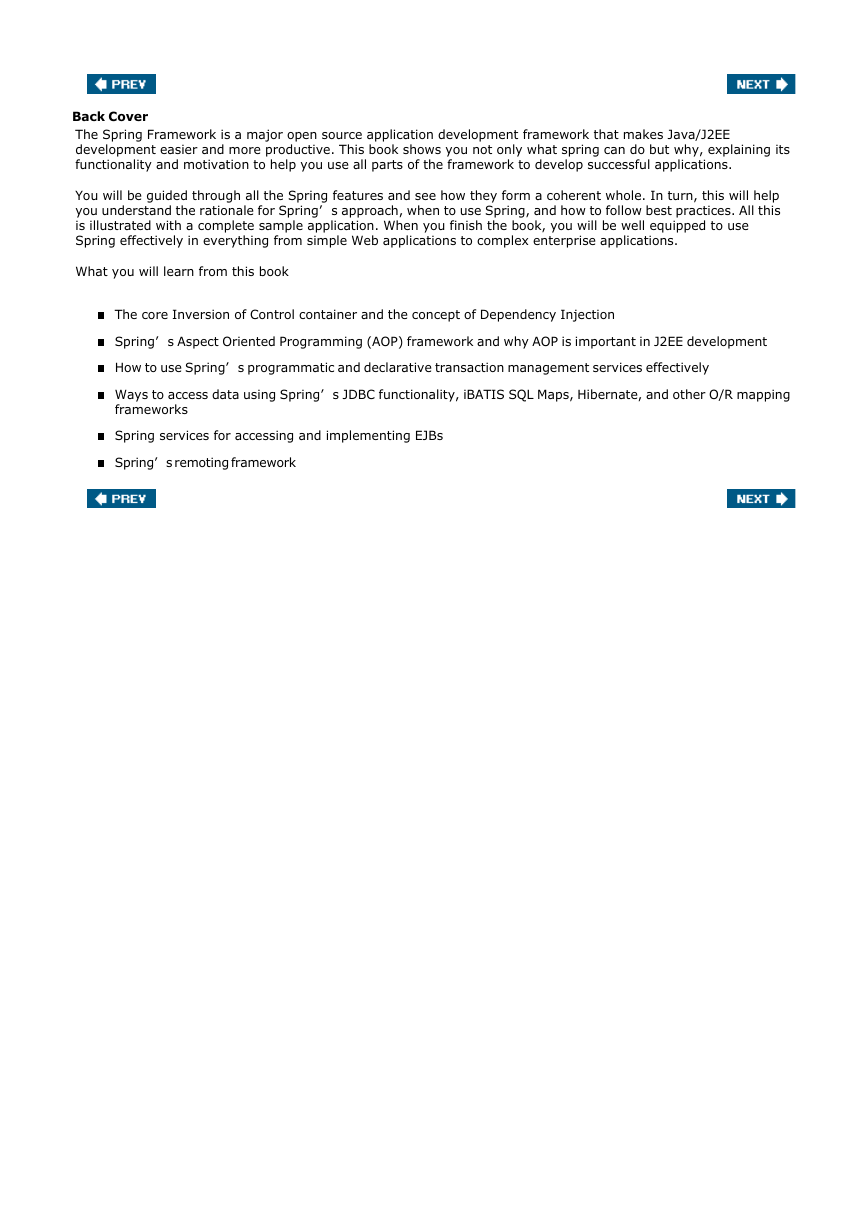
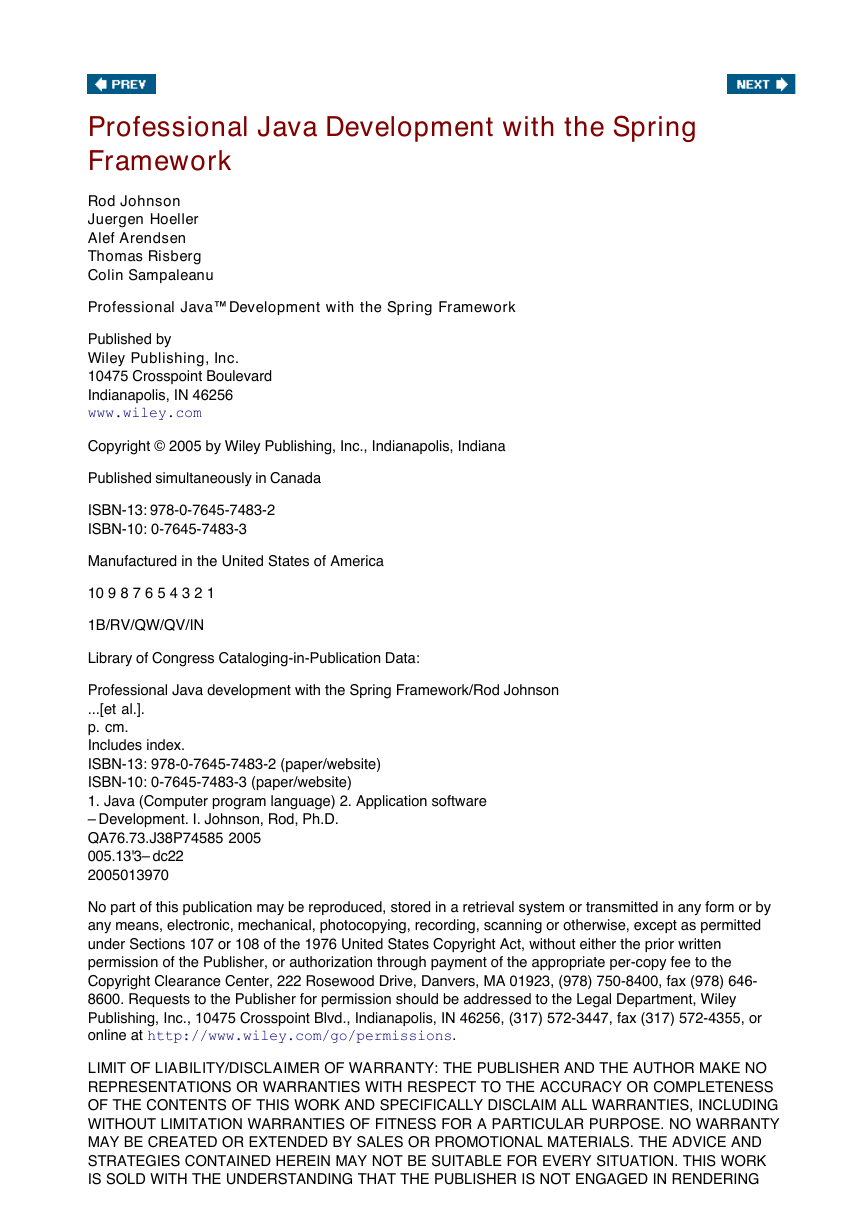
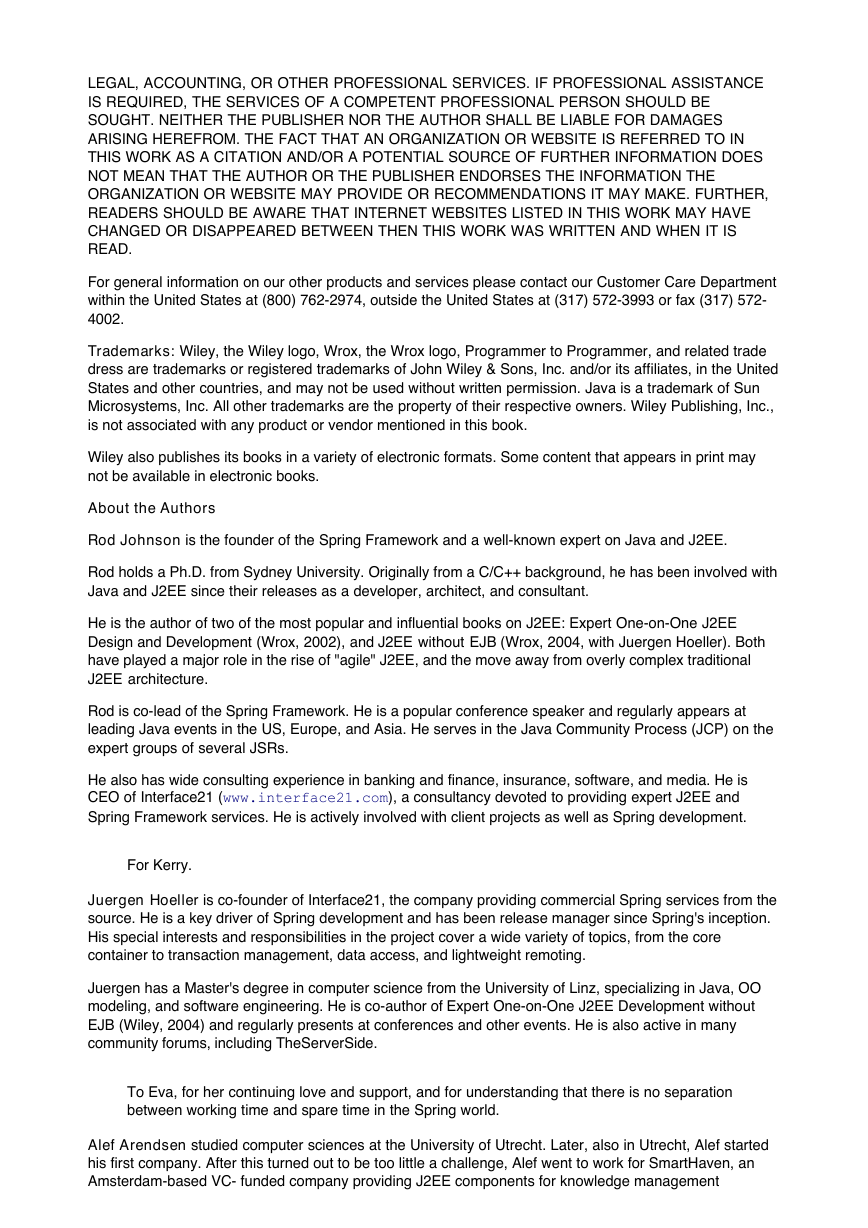
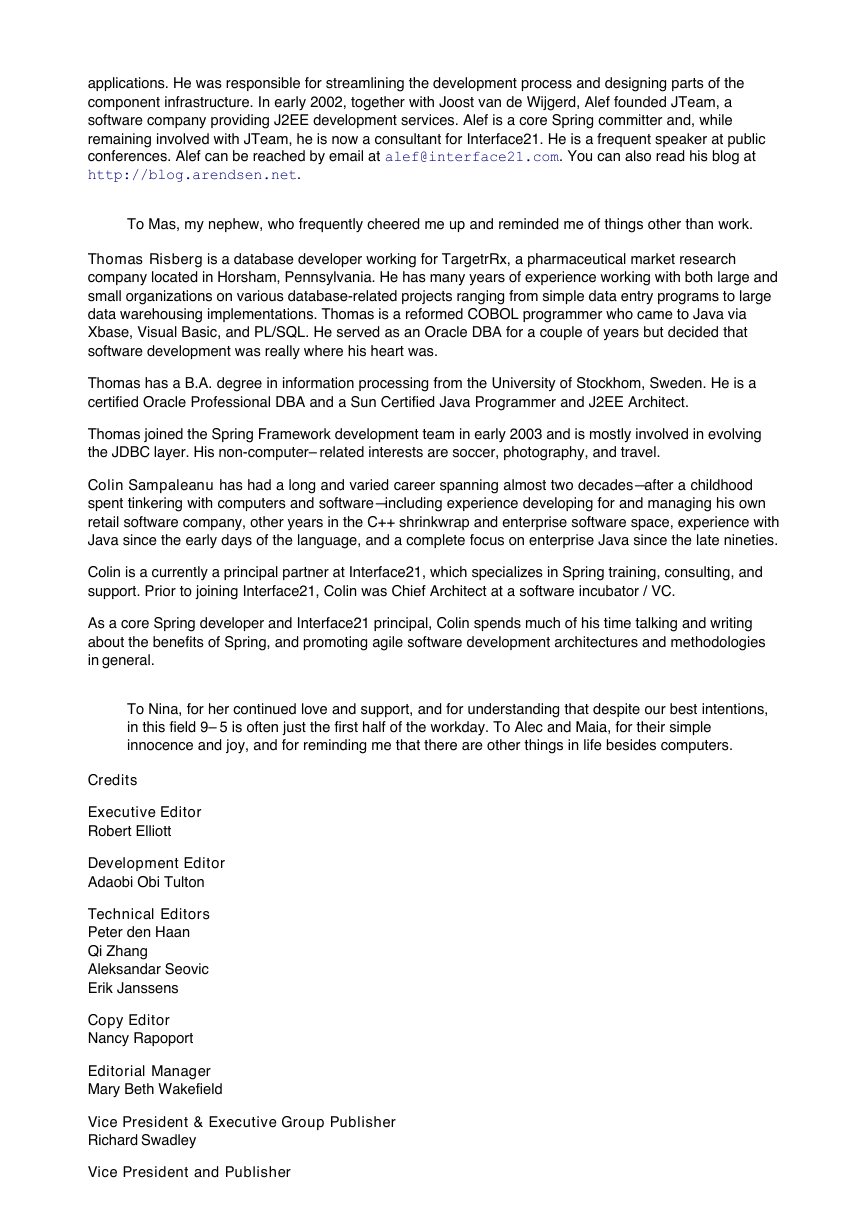
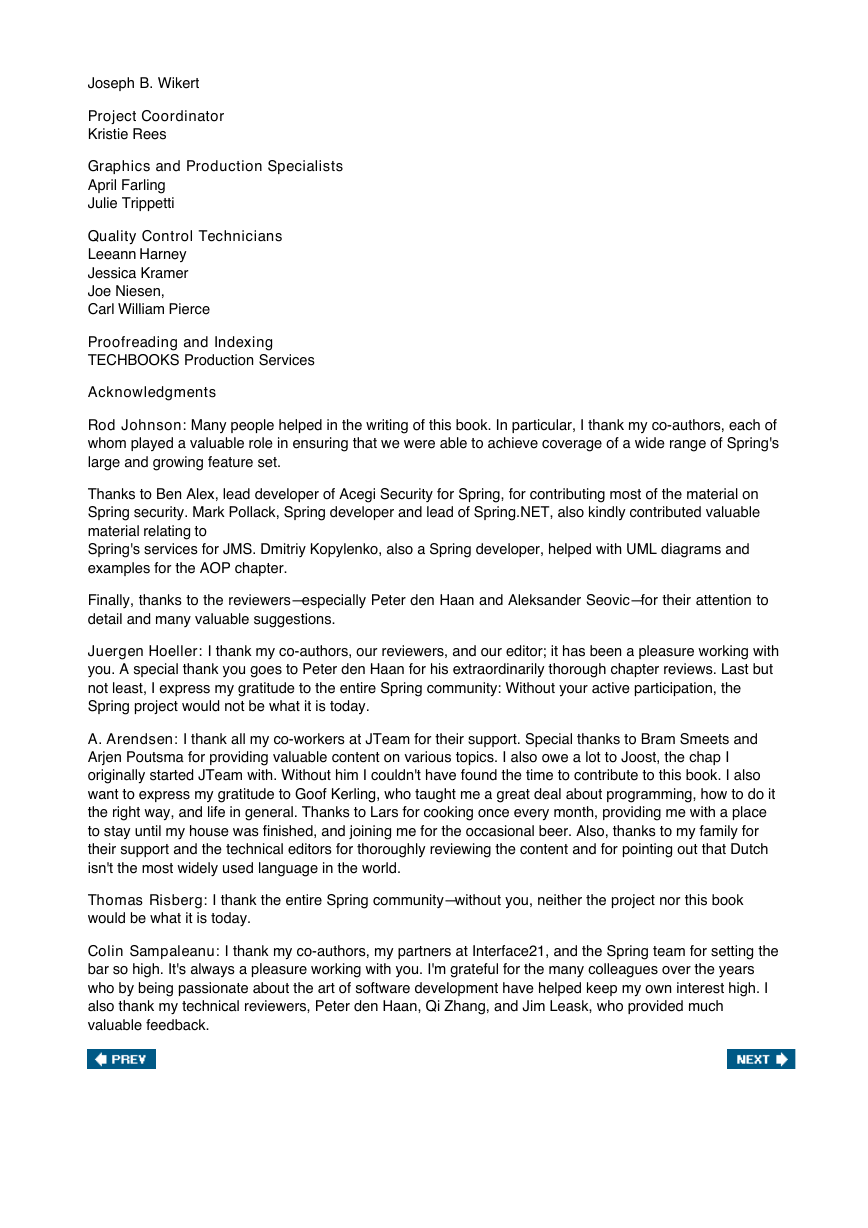










 2023年江西萍乡中考道德与法治真题及答案.doc
2023年江西萍乡中考道德与法治真题及答案.doc 2012年重庆南川中考生物真题及答案.doc
2012年重庆南川中考生物真题及答案.doc 2013年江西师范大学地理学综合及文艺理论基础考研真题.doc
2013年江西师范大学地理学综合及文艺理论基础考研真题.doc 2020年四川甘孜小升初语文真题及答案I卷.doc
2020年四川甘孜小升初语文真题及答案I卷.doc 2020年注册岩土工程师专业基础考试真题及答案.doc
2020年注册岩土工程师专业基础考试真题及答案.doc 2023-2024学年福建省厦门市九年级上学期数学月考试题及答案.doc
2023-2024学年福建省厦门市九年级上学期数学月考试题及答案.doc 2021-2022学年辽宁省沈阳市大东区九年级上学期语文期末试题及答案.doc
2021-2022学年辽宁省沈阳市大东区九年级上学期语文期末试题及答案.doc 2022-2023学年北京东城区初三第一学期物理期末试卷及答案.doc
2022-2023学年北京东城区初三第一学期物理期末试卷及答案.doc 2018上半年江西教师资格初中地理学科知识与教学能力真题及答案.doc
2018上半年江西教师资格初中地理学科知识与教学能力真题及答案.doc 2012年河北国家公务员申论考试真题及答案-省级.doc
2012年河北国家公务员申论考试真题及答案-省级.doc 2020-2021学年江苏省扬州市江都区邵樊片九年级上学期数学第一次质量检测试题及答案.doc
2020-2021学年江苏省扬州市江都区邵樊片九年级上学期数学第一次质量检测试题及答案.doc 2022下半年黑龙江教师资格证中学综合素质真题及答案.doc
2022下半年黑龙江教师资格证中学综合素质真题及答案.doc